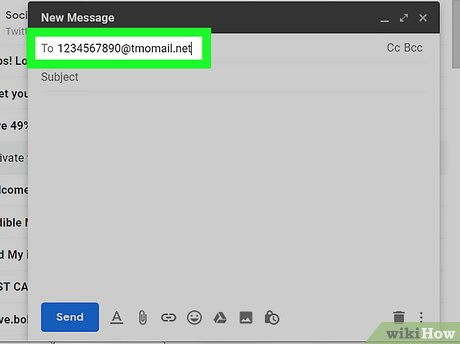In the interconnected world we live in, communication is key. While email and text messaging are some of the most popular forms of staying in touch, not everyone knows you can actually send an email directly to a cell phone number. This process is simple once you understand how it works, and it’s a useful trick to get a message to someone who may not have immediate access to their email. Below, we’ll explore various methods to send emails to a cell phone as text messages, so you can choose the one that fits your needs best.

Email-to-SMS Gateway
Most mobile carriers offer a feature where emails sent to a specific address are converted into SMS messages. These addresses usually follow the format of "[email protected]", and when an email is sent to this address, it arrives as a text message.
- Find the recipient’s SMS gateway address. You’ll need to know the carrier they use and their cell phone number.
- Compose an email. Use your standard email application to write your message.
- Send the email to the SMS gateway address.
Summary: This method is very straightforward and doesn’t require additional apps or services. However, it might not support multimedia messages, and the character limit is typically constrained to the standard text message limit.
MMS Gateway
Similar to the Email-to-SMS method, carriers also provide MMS gateway addresses that can be used to send not just text, but also media content such as pictures and sounds.
- Identify the recipient’s MMS gateway address. This requires knowing the carrier.
- Compose your email with or without multimedia attachments.
- Email the content to the MMS gateway address.
Summary: The MMS Gateway method extends the functionality by including multimedia. The downside is larger emails might be truncated or may incur additional charges for the recipient.
Online Text Messaging Services
Various online services act like a bridge, converting your email messages to text messages. These services typically require registration and might come with additional features.
- Sign up for a reliable online text messaging service.
- Verify your email address if required.
- Compose and send your message using the platform’s interface.
Summary: Online text messaging services are user-friendly and offer extra features, but they require internet access and may come with service costs.
Email Client SMS Extensions
Some email clients offer extensions or add-ons that enable you to send SMS directly from your email interface.
- Find and install a reputable SMS extension for your email client.
- Set it up by following the provided instructions.
- Use the extension to send your message as an SMS.
Summary: This method is great for those who frequently send emails to SMS, offering convenience within the email client. However, extension compatibility and charges may vary.
Social Media Platforms
Some social media platforms offer the ability to send a message which can also be received as a text message on a user’s phone.
- Use the recipient’s social media information to send a message.
- Ensure the recipient has their phone number linked and notifications enabled.
- They will receive your message as a notification, which can include a text message.
Summary: Social media platforms are widely used, making it convenient, but the recipient’s phone settings must be correctly configured to receive messages as texts.
Mobile Carrier’s Website
Many mobile carriers have a section on their website that allows you to send a text message to one of their subscribers.
- Visit the mobile carrier’s website.
- Find the “Send a Text Message” feature.
- Enter the recipient’s phone number and your message, then send it.
Summary: This method is carrier-specific and free, but it works only for subscribers of that specific carrier and may have a limited number of characters.
Email Software With SMS Integration
Certain email software includes an SMS integration feature that allows you to send messages directly to a phone number.
- Check if your current email software has an SMS integration feature.
- Set it up according to the software instructions.
- Use the feature to send your email as an SMS.
Summary: Having integration within your email software is seamless and efficient, but setup might be complex, and additional fees may apply.
Browser Extensions
Browser extensions can enable SMS sending capability right from your web browser.
- Find a trusted browser extension that allows SMS messaging.
- Install the extension and configure it with your details.
- Send messages through the extension interface.
Summary: Browser extensions offer good convenience, but they can raise security concerns, and you must verify the trustworthiness of the extension.
Cross-Platform Messaging Services
Messaging services that work across different devices and platforms can also send messages that can be received as texts.
- Register for a cross-platform messaging service.
- Make sure the recipient is also using the service and has an account.
- Compose and send your message through the app or website.
Summary: Cross-platform services are versatile, but both sender and recipient must use the same service, and this might not be actual SMS.
Email Client Configuration
Some email clients can be directly configured to send SMS if they have support for the service.
- Explore your email client settings to see if SMS functionality is supported.
- Configure the SMS settings with details such as the recipient’s phone number and carrier.
- Send your email, which the email client will dispatch as an SMS.
Summary: This method eliminates the need for third-party tools or services, but it’s generally limited to enterprise email solutions and requires technical configuration.
Tips and Tricks
- Always ensure you have the right SMS or MMS gateway address for the recipient’s carrier.
- Keep your message short to prevent it from being split into multiple texts.
- Some wireless carriers charge for receiving SMS or MMS messages, so consider the recipient’s potential costs.
In conclusion, sending an email to a cell phone number is quite adaptable, with various methods available to suit different requirements and circumstances. From utilizing carrier-specific gateways to employing third-party services, individuals have the flexibility to communicate across platforms effortlessly. While each approach comes with its own set of benefits, it’s essential to consider any potential limitations or costs involved.
FAQs:
-
Is it free to send emails to a cell phone as text messages?
Ans: It can be free, but it depends on the service and method used. Recipients might incur standard messaging costs from their carrier. -
Will I receive a reply if I send an email to a cell phone number?
Ans: Yes, if the recipient replies, it will typically come back to your email inbox. -
Can I send attachments to a cell phone number from an email?
Ans: Yes, but you should use the MMS gateway of the recipient’s mobile carrier, and the file size must be small enough to be supported by MMS limitations.









